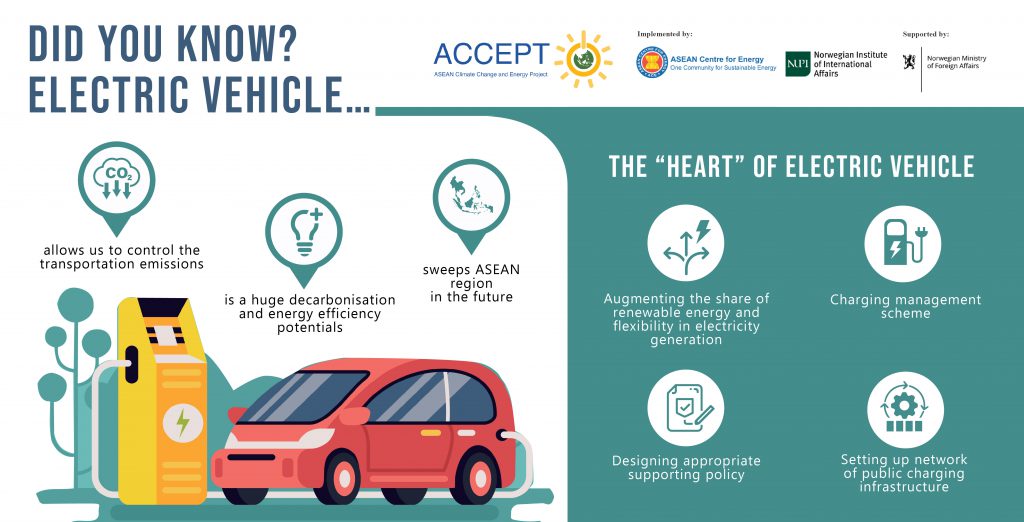Electric vehicle (EV) penetration and other transportation manoeuvre in combating climate change continue set the story in transportation sector as huge decarbonisation and energy efficiency potentials could be achieved from them. Not only is EV technology approaching a tipping point as better performing, more affordable, and new model, but also this technology allows us to control the transportation emissions centrally through power plants.
Undoubtedly, the EV wave would also sweep ASEAN region in the future. Albeit issues due to the high emission factor in the electricity sector, it is still imperative that ASEAN member states be prepared to optimally take the opportunity.
The Checkpoint of Electric Vehicle
Nearly two centuries ago, the first EV appeared on the transportation scene but unfortunately ended up pushed to the side by the advances of Internal Combustion Engine vehicles.
The true revival of EV did not happen until around the start of the 21st century. It is thanks to automotive companies and battery manufacturers, who interminably continue to innovate and reduce the major battery cost in EV. EV starts returning onto the road powered with the advancement in battery life and efficiency, becoming feasible for a wide range of business and personal uses. Moreover, EV charging technologies including fast charging, wireless charging, and battery swapping are steadily evolving to address consumers’ driving range anxieties.
Coupled with supports stemming from government policies, EV are currently capable to grapple with other vehicle types in the automotive market. In fact, global EV sales were close to two million in 2018 with China stood high with highest volume of EV sales and charging infrastructure worldwide, followed by Europe and the United States. However, this situation is not homogenous globally due to several barriers that make EV uptake remain stuck.

The “Heart” of Electric Vehicle Uptake
In order to experience the virtue of EV, all key determinants have to collaborate in tackling the barriers of EV uptake.
First and foremost, the power sector green up. EV might cut oil consumption and its related emissions, but it also ramps up the carbon-intensive electricity. To fully unleash EV’s climate change mitigation impact, the utility must augment the share of renewable energy and flexibility in electricity generation before massive EV adoption. The abundance of renewable energy in the region should be complemented by strong government policy to become the “starting motor” for accelerated investment in carbon-free electricity generation.
Another essential thing is Charging Management Scheme. High EV uptake with uncoordinated charging can cause disturbance in power grid. Controlled EV charging could smooth the demand pattern on the local grid through charging management schemes such as off-peak charging, combined smart and cost-oriented charging, and renewable energy-oriented charging. Charging scheme strategy needs to be planned as early as possible to ensure that additional electricity demand does not further burden the electricity grid. Besides powering the vehicle, EV has potential to store energy in battery and provide energy to grid/home. These capabilities have two advantages namely consumer could address disturbance in local level and participate in electricity market.
Related to that, Google recently announces its latest breakthrough “Carbon-Intelligent Computing Platform” shifting energy-intensive computing processes in data centre to when renewable energy is at its peak. Further, the company is developing “flexible compute tasks” between different data centres. The same approach would allow households and businesses to minimise emissions through a localised demand response. Innovation such these could enhance power system flexibility to facilitate renewable energy integration.
Designing appropriate supporting policy is key requirement to stimulate EV market. China’s supporting policies successfully broke the consensus about expensive costs of EV. Instead, it is shown that the objectives of emission reduction and EV market targets could be attained simultaneously. Subsidies are the main driver to bridge price disparity between ICE and EV and other incentive-bundle measures such as exemption tax, free charging, sales ban of ICE, carbon tax are another highly effective measures to stimulate consumers switching to EV.
Beside consumers, concrete and reasonable policies for EV deployment will encourage producers, as well. Hyundai has announced a $1.55 billion investment plan to develop EV in Indonesia over the next decade after Joko Widodo signed a decree supporting EV industry. Meanwhile, Thailand Board of Investment announced that the country has received more foreign direct investment supporting the country’s growing EV production ecosystem. Local companies in other ASEAN member countries such as SP Group, Gesits, Grab, VinFast also captured the positive policy signal and entered the battleground in supplying charging infrastructure, two-wheelers, and commercial fleets. However, another major barrier hampering the deployment comes in the form of charging infrastructure.
Setting up network of public charging infrastructure is equally crucial in creating demand for EV. The shortage of charging infrastructure becomes a major roadblock on the transition toward EV. High-cost investment becomes the main barrier to this technology. By the end of 2018, Energy Absolute, a Thai company has established and operated 1000 EV charging stations. In Indonesia, the state-owned utility PLN heavily developed EV infrastructure up to 200 charging stations in 10 cities. Albeit typical progresses in several ASEAN member states, this small number is still a far cry from a proper public scale utility, enough to incentivise private sector participation.
Even so, in the near term, the government could engage public through awareness programs, such as EV public transport and mobility management such as ridesharing (carpooling), park-and-ride facilities, and road pricing policies. These strategies, if become widespread, would reduce energy demand in great quantities while initiating EV awareness in the public.
Transitioning to green mobility is inevitable. EV holds a lot of potential for creating a more sustainable future. ASEAN member states have shown a positive direction of early phase by adopting EV in their commercial and two-wheeled fleets. However, long and winding road must be dealt with to create a sustainable regional market. Finally, fundamental questions pop up: Will the revival of EV truly reshape the future of mobility? If you agree with that, are we prepared to overcome the challenges?
Reference:
(Photo Credit: Mike Bird)